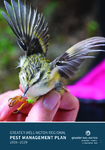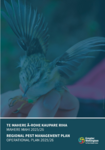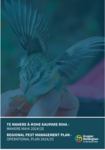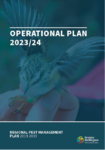Picture a region filled with flourishing native plants, flitting birds, crawling insects, and healthy ecosystems. A resilient natural environment around us, not just for our native species, but for our health and wellbeing too.
We’re striving to make this vision a reality in the Wellington Region, with a plan that builds on what we’ve already achieved in biosecurity, and guides us through the next twenty years of pest control. This plan represents a more connected approach to protecting the most valued spots in the region. It also means more collaboration with organisations and communities for a better future.
Greater Wellington Regional Pest Management Plan 2019-2039 – amended 26 Sep 2023

We are very pleased to introduce the Greater Wellington Regional Pest Management Plan 2019-2039. After a year of discussions, with the public, organisations, volunteer groups and others, we’re proud of… Read more here

date_range Published 02 Jul 2019
Download now (PDF 11 MB) get_appAbout the Plan
The Greater Wellington Regional Pest Management Plan 2019-2039 provides the strategic direction for managing pest plants and animals in our region for the next 20 years. It remains flexible for adjustments if situations change, and it does not set out our day-to day operational planning, which is outlined in our annual Operational Plan.
This plan builds on the legacy of the past 20 years of pest control, and is the result of a large collaborative effort, including public consultation. The success of our programmes in the past and in the future is down to the support of communities, volunteers, and other organisations working in pest management. This includes large scale community projects such as Predator Free Wellington and mainland islands such as Zealandia, Wainuiomata Mainland Island, East Harbour Mainland Island, and Pukaha Mount Bruce.
Pest Management Programmes
Species in the Regional Pest Management Plan are classified under management programmes depending on their presence in the Wellington Region, and whether or not it is possible to achieve the desired level of control. These include:
Exclusion: to keep out invasive species that we do not have in the Wellington region.
Eradication: to remove them from the region over time.
Progressive containment: to reduce the area they have spread over time.
Sustained control programme: to reduce their impact and spread.
Site-led programme: to control them in specific areas to protect the values of that place.
Pest plants
The plants identified in the Regional Pest Management plan are included under five management programmes:
- Exclusion – Alligator weed, chilean needle grass, nassella tussock.
- Eradication – Moth plant, senegal tea, spartina, velvetleaf, woolly nightshade.
- Progressive containment – Purple loosestrife, wilding conifers.
- Sustained control – Blue passionflower, boneseed, climbing spindleberry, eelgrass.
- Site-led programmes – Banana passionfruit, cathedral bells, old man’s beard.
More information on pest plant species.
Pest animals
The animals identified in our Regional Pest Management Plan are included under four management programmes:
- Exclusion – Wallabies (Bennett's and dama).
- Eradication – Rooks.
- Sustained control – Wasps (common, German, Australian and Asian paper wasp), feral rabbits.
- Site-led programmes – Rats, possums, pest cats, mustelids (ferret, stoat and weasel), magpie, feral goat, feral deer, european hedgehog.
More information on pest animal species.
The Operational Plan
Under the Biosecurity Act, we need to review the RPMP Operational Plan annually and adjust it if needed. We also need to produce an Operational Plan Report annually.
This provides transparency by summarising what we've done during the year and the results, and so is also a measure of accountability.
Regional Pest Management Plan 2019-2039 - Operational Plan 2025/26

The Regional Pest Management Plan 2019-2039 (RPMP) was prepared in accordance with the Biosecurity Act 1993 and became operative on the 2nd of July 2019.
This Operational Plan has been prepared…
Read more here

date_range Published 25 Aug 2025
Download now (PDF 854 KB) get_appRegional Pest Management Plan – Operational Plan Report 2024/25

This document reports against the achievements and outcomes of Greater Wellington’s biosecurity related activities. The work programme was set by the RPMP Operational Plan 2024/25 and aligns with the Greater… Read more here

date_range Published 28 Nov 2025
Download now (PDF 4.8 MB) get_appRegional Pest Management Plan 2019-2039 - Operational Plan 2024/25

The Regional Pest Management Plan 2019-2039 (RPMP) was prepared in accordance with the Biosecurity Act 1993 and became operative on the 2nd of July 2019.
This Operational Plan has been prepared…
Read more here

date_range Published 02 Sep 2024
Download now (PDF 1.5 MB) get_appRegional Pest Management Plan 2019-2039 - Operational Plan 2023/24

The Regional Pest Management Plan 2019-2039 (RPMP) was prepared in accordance with the Biosecurity Act 1993 and became operative on the 2nd of July 2019.
This Operational Plan has been prepared…
Read more here

date_range Published 17 Jan 2024
Download now (PDF 1.1 MB) get_appGet in touch
- Phone:
- 0800 496 734
- Email:
- info@gw.govt.nz
